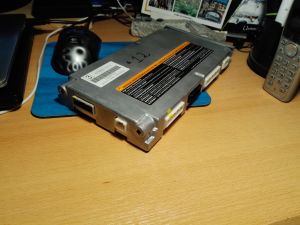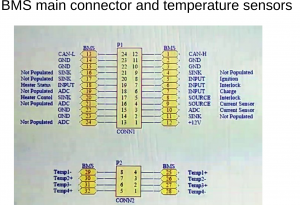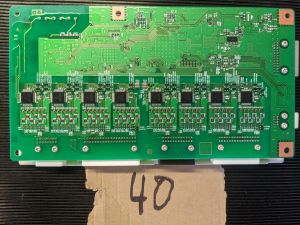Nissan Leaf BMS: Difference between revisions
Added a diagram, I think it belongs here, took me a moment to dig it out the forum. |
Added 40kWh section & Photograph |
||
| Line 445: | Line 445: | ||
Pins for CAN-H and CAN-L and others as identified by wolftronix in the diagram below. Pins are for LB11 and LB12 connectors in Nissan terminology. | Pins for CAN-H and CAN-L and others as identified by wolftronix in the diagram below. Pins are for LB11 and LB12 connectors in Nissan terminology. | ||
[[File:Nissan Leaf BMS Connector Pins LB11 LB12.png|thumb|LB11 LB12 mappings]] | [[File:Nissan Leaf BMS Connector Pins LB11 LB12.png|thumb|LB11 LB12 mappings]] | ||
=== 40kWh BMS === | |||
The pinout for +12V, CAN-H, CAN-L, Ignition and HV is identical. | |||
Internally it appears to use a daisy chain of MAX17823B for sensing cell voltages. | |||
[[File:40kwh Nissan Leaf BMS.jpg|thumb]] | |||
Revision as of 17:45, 15 September 2021
Here we collect information about Nissans BMS.
Connectors
Credit goes to Wolftronix for figuring this out.
You will also find it on the diyelectriccar forum, you will need to sign up for downloading
| P4 24 pin | P3 32 pin | P6 16 Pin | P5 40 Pin | ||||||||||||
| Pin | Cell | Cell | Pin | Pin | Cell | Cell | Pin | Pin | Cell | Cell | Pin | Pin | Cell | Cell | Pin |
| 1 | 1 | 13 | 1 | 21 | 17 | 1 | 9 | 1 | 61 | 60 | 21 | ||||
| 2 | 3 | 2 | 14 | 2 | 23 | 22 | 18 | 2 | 49 | 48 | 10 | 2 | 63 | 62 | 22 |
| 3 | 5 | 4 | 15 | 3 | 25 | 24 | 19 | 3 | 51 | 50 | 11 | 3 | 65 | 23 | |
| 4 | 7 | 6 | 16 | 4 | 27 | 26 | 20 | 4 | 53 | 52 | 12 | 4 | 67 | 64 | 24 |
| 5 | 9 | 8 | 17 | 5 | 29 | 28 | 21 | 5 | 55 | 54 | 13 | 5 | 69 | 66 | 25 |
| 6 | 11 | 10 | 18 | 6 | 31 | 30 | 22 | 6 | 57 | 14 | 6 | 71 | 68 | 26 | |
| 7 | 13 | 12 | 19 | 7 | 33 | 32 | 23 | 7 | 59 | 56 | 15 | 7 | 73 | 70 | 27 |
| 8 | 15 | 14 | 20 | 8 | 34 | 24 | 8 | 58 | 16 | 8 | 75 | 72 | 28 | ||
| 9 | 16 | 21 | 9 | 35 | 36 | 25 | 9 | 77 | 74 | 29 | |||||
| 10 | 22 | 10 | 37 | 38 | 26 | 10 | 79 | 76 | 30 | ||||||
| 11 | 17 | 18 | 23 | 11 | 39 | 40 | 27 | 11 | 78 | 31 | |||||
| 12 | 19 | 20 | 24 | 12 | 41 | 42 | 28 | 12 | 81 | 80 | 32 | ||||
| 13 | 43 | 44 | 29 | 13 | 83 | 82 | 33 | ||||||||
| 14 | 45 | 46 | 30 | 14 | 85 | 84 | 34 | ||||||||
| 15 | 47 | 48 | 31 | 15 | 87 | 86 | 35 | ||||||||
| 16 | 49 | 32 | 16 | 89 | 88 | 36 | |||||||||
| 17 | 91 | 90 | 37 | ||||||||||||
| 18 | 93 | 92 | 38 | ||||||||||||
| 19 | 95 | 94 | 39 | ||||||||||||
| 20 | 97 | 40 | |||||||||||||
Connector part numbers
In case you need to adapt or extend the sense wires, you will need the male and female connectors and the respective pins. Here are the part numbers:
| Part | Number | Notes |
| 16-pole male | 1473796-1 | |
| 16-pole female | 1318386-1 | |
| 24-pole male | 1376103-1 | |
| 24-pole female | 1318917-1 | |
| 32-pole male | 1473799-1 | |
| 32-pole female | 1318747-1 | |
| 40-pole male | 1376113-2 | Solder part, crimp not available |
| 40-pole female | 1318389-1 | |
| Pin male | 1376109-1 | |
| Pin female | 1123343-1 |
CAN Messages
Upon powerup the unit spits out messages that contain various useful info. After a while these messages stop and you have to send 50B#00 00 00 C0 00 00 00 to get it going again.
All messages are big endian, i.e. hi-byte, lo-byte!
To get the individual cell voltages, first issue 79B#02 21 02 FF FF FF FF FF. You will receive the first reply looking like this: 7BB#10 C6 61 02 0E C9 0E C0.
Now send 27 times 79B#30 01 00 FF FF FF FF FF and you get 7BB#21 0E C0 0E C2 0E C0 0E. It is one index byte and 7 data bytes. So after 28 messages you will have collected 98 words (16-bit) of data. Every other message it stretches over to the next message. The first the last two words are unknown so we discard them. That leaves us with 96 Words that represent the cell voltages in mV in big endian format.
https://docs.google.com/spreadsheets/d/1EHa4R85BttuY4JZ-EnssH4YZddpsDVu6rUFm0P7ouwg/edit#gid=7
Different Versions

Their seem to be at least two different versions of the LBC out there, as discovered here: https://openinverter.org/forum/viewtopic.php?f=13&t=370&start=10
The earlier version has only white input headers while the later version has ONE black HV header and a grey low voltage header. We call the first version the "white" BMS and the later version the "grey" BMS.
Treated as a black box the main differences are:
- Interlock is between Pin 8 and Pin 21 on white BMS as opposed to Pin 8 and Pin 6 on grey BMS
- Ignition input is on pin 6 on white as opposed to pin 7 on grey
- White BMS expects 4 temperature sensors, grey BMS only 3
- Supposedly the current sensors GND is on Pin 7 but I found Pin 7 internally unconnected and left GND on Pin 15
So if you have a "grey" wiring loom but a white LBC you need to move Pin 6 over to Pin 21 and Pin 7 to Pin 6.
To mitigate the missing temperature sensor you need to bridge the two input internally behind the input stage. Therefor remove R59. Then Find R62 and bridge it over to the adjacent channel 4. If you want you can use the resistor you just removed.
CAN connector pins
Pins for CAN-H and CAN-L and others as identified by wolftronix in the diagram below. Pins are for LB11 and LB12 connectors in Nissan terminology.

40kWh BMS
The pinout for +12V, CAN-H, CAN-L, Ignition and HV is identical.
Internally it appears to use a daisy chain of MAX17823B for sensing cell voltages.
